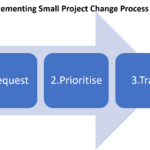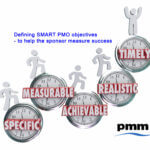If you have followed the last 3 posts, you will have an understanding of why it is important to determine clear sponsor requirements, convert to SMART objectives, create PMO Vision and Mission statements to allow the definition of PMO design principles that are aligned to objectives. All well and good. Now the PMO needs to be implemented.
Like with any project – you need a plan. While there is no such thing as a standard / generic PMO (all organisations are different), there are common tools and processes that you just need to have. So while some people are right to say there is no “cookie cutter”, it is equally true that there are common tools and processes that all PMO’s should have and that it makes sense to use“frameworks” as they save time, provide guidance and can be refined to suit the needs of your organisation.
PMO Framework Building Blocks
PMO framework building blocks
A quick recap of what every PMO will probably need as they mature:
- PMO governance
- PMO organisation
- PMO planning
- PMO cost management
- PMO benefits management
- PMO RAIDs
- PMO reporting
- PMO quality assurance
- PMO change control
- PMO resource management
- PMO communication management
- PMO procurement
- PMO document storage
Typical Steps for each Building Block
Having an understanding of the building blocks allows you to map out a project plan with clear deliverables for each.
A simple example being:
Cost Management
- Environment scan for current process
- Define requirements
- Check requirements against objectives and design principles
- Validate existing Cost Management process against requirements
- Define / update Cost Management process to meet requirements
- Define tools / templates
- Define processes
- Review tools, templates and processes with stakeholders
- Communication of tool, templates and processes
- Training
- Implement
Of course this is generic and you should adapt for your own needs. However, what I wish to convey is the type of steps you can use for each of the building blocks in the framework to quickly implement a PMO. Remember, the PMO will constantly evolve and be refined so does not have to be 100% perfect at day 1.
Use a Roadmap
When you have defined all of the blocks you need and worked out timescales, use the plan to create a single page PMO Roadmap. This will allow you to easily communicate the roll-out plan to stakeholders. This should help them understand approach and make it easier to get their buy-in. A good tip is to try and add benefits to the Roadmap that link back to the original objectives. For example, where a sponsor was frustrated about not having visibility of projects. Add a milestone at the end of the reporting block to show “all projects using standard reporting”.
Report Progress
Don’t be guilty of “do as I say not as I do”. Hold your self to account. Make sure you produce a regular status report to show progress (ideally using the proposed standard report). That way the sponsor will not be nervous and worried about what is going on, they are regularly reminded of the benefits and you can secure help where needed.
Communication
Very important – ensure you are communicating the plans, especially to the project managers. Engage with the project managers, seek their feedback. You do not want to implement a PMO only to be told it will not work because of X, Y, Z. Get them on-board early and let them contribute and help evolve the solution.
Training
Ensure that training is part of the plan. Always make sure that all project managers and project teams are offered additional training. It helps answer any questions they have as opposed to them going round saying it does not work because they do not understand. The more training you put in at the start, the less issues you will have as they start using the PMO tools and processes.
Implement
Self explanatory – you need to implement the PMO. The good news it can be, and i recommend that, it should be phased. This will stop overwhelm and allow for the delivery of incremental benefit.
To close
All PMO’s are different. However, there are common tools and processes so using a framework allows for rapid definition and deployment. Each step ensure that you check back to the objectives and design principles. Keep everyone on board with regular communication.
The next, final post in this series will cover how you measure success against the original objectives.
If you would like more information on defining and setting up a PMO, please take a look at the post on PMO Set-up.






